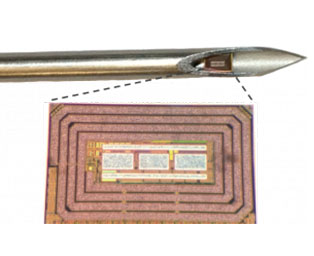Connected Health
Powering and Communicating with the Internet-of-(Medical)-Things (IoMT)
Wearable devices have the potential to disrupt healthcare by enabling a remote interface between doctor and patient. However, most wearable sensors today, including smartphones and fitness trackers, are limited to motion sensing. They sense few, if any, medically relevant physiological parameters. We recently developed an implantable biomedical device for continuous in vivo biomarker measurements that could transform healthcare and enable precision medicine – the concept of accurately tailoring pharmaco- logical treatment to the individual. These “BioMote” sensors are the size of a single grain of rice (< 1 mm3) and injected through a 16-gauge needle into interstitial fluid (ISF) – the quasi-stationary extracellu- lar fluid surrounding cells. To reduce the size and potential toxicity, the BioMote is powered wirelessly. Wireless power transmission and backscatter communication (via load shift keying) is widely used today to read RFID tags and is a promising approach to enable ultra-low-power implantable mm3-scale implantable medical devices. However, there are significant challenges translating such an approach to biomedical ap- plications that have significant path loss due to tissue absorption (~80 dB) and transmitter leakage, which acts as a blocker (>70 dB) at the carrier frequency for the receiver.
In this effort, we will design a low-power wearable “relay” device that can wirelessly power and communicate with body-worn and implanted IoMT devices. The relay will then send the data to an aggre- gator for further processing using an ultra-low power transmitter in the Medical Implant Communication System (MICS)-band. To address the transmitter leakage, we propose a feedforward transceiver cancella- tion scheme that will not desensitize the receiver and enable recovery of the backscattered signal. The MICS transmitter will consist of a new technique for process, voltage, and temperature (PVT)-robust, cal- ibration- and regulation-free synthesis of the RF carrier based on generating poly-phasors at 50 MHz and combining them with an 8× edge combiner to generate the 400 MHz carrier without a PLL. An inverse class-E power amplifier will be implemented for high efficiency at low output power (-17.5 dBm). Open- loop operation will allow aggressive duty-cycling (< 40 ns start-up time). If fully funded, we expect to achieve state-of-the-art performance from the relay device and the MICS transmitter.
